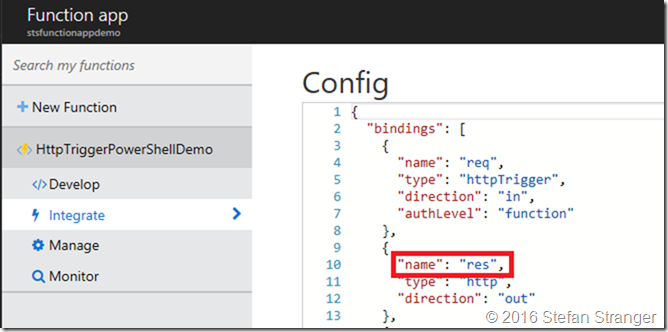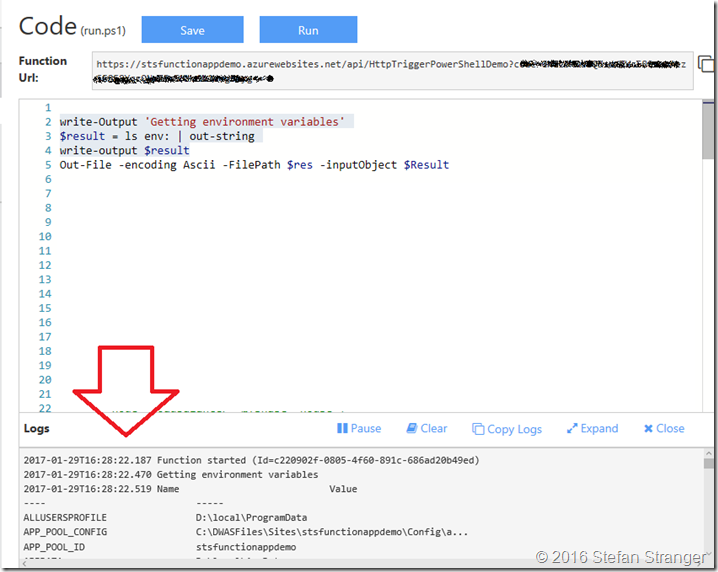PowerShell Azure Functions lessons learned
Lately I’m playing with PowerShell Azure Functions and I learned there are some things I needed to learn and that’s why I want to share some more info about this topic.
What are Azure Functions?
Azure Functions is an event driven, compute-on-demand experience that extends the existing Azure application platform with capabilities to implement code triggered by events occurring in virtually any Azure or 3rd party service as well as on-premises systems. Azure Functions allows developers to take action by connecting to data sources or messaging solutions, thus making it easy to process and react to events. Azure Functions scale based on demand and you pay only for the resources you consume. (from Github)
On the Github page about Azure Functions you can find all the info to get started.
PowerShell Azure Functions
Azure Functions enables you to create scheduled or triggered units of code implemented in various programming languages. PowerShell is one of those programming languages.
A good starting point is a blog post from David O’Brien Azure Functions – PowerShell.
If you look at an example from David you see a special variable being used ‘$res’. At first it was not clear to me where this variable was being defined. To find out more I started to create a Function using the Get-Variable cmdlet.
Use the following PowerShell script in your Function to retrieve the automatic variables available in Azure PowerShell functions.
[sourcecode language='powershell' padlinenumbers='true'] write-Output 'Getting variables' $result = Get-Variable | out-string [/sourcecode]
If you run this in your Azure PowerShell function you will see the following in your logs section.
[sourcecode language='powershell' ]
2017-01-29T16:01:51.538 Function started (Id=6528a25c-61cc-4d16-90ad-4869e47dc599)
2017-01-29T16:01:51.867 Getting variables
2017-01-29T16:01:51.898 Name Value
---- -----
$
? True
^
args {}
ConfirmPreference High
ConsoleFileName
DebugPreference SilentlyContinue
Error {}
ErrorActionPreference Continue
ErrorView NormalView
ExecutionContext System.Management.Automation.EngineIntrinsics
false False
FormatEnumerationLimit 4
HOME
Host System.Management.Automation.Internal.Host.Int...
input System.Collections.ArrayList+ArrayListEnumerat...
InvocationId 6528a25c-61cc-4d16-90ad-4869e47dc599
MaximumAliasCount 4096
MaximumDriveCount 4096
MaximumErrorCount 256
MaximumFunctionCount 4096
MaximumHistoryCount 4096
MaximumVariableCount 4096
MyInvocation System.Management.Automation.InvocationInfo
NestedPromptLevel 0
null
OutputEncoding System.Text.ASCIIEncoding
outputFile D:\local\Temp\Functions\Binding\6528a25c-61cc-...
PID 9936
ProgressPreference Continue
PSBoundParameters {}
PSCommandPath
PSCulture en-US
PSDefaultParameterValues {}
PSEmailServer
PSHOME D:\Windows\SysWOW64\WindowsPowerShell\v1.0
PSScriptRoot
PSSessionApplicationName wsman
PSSessionConfigurationName http://schemas.microsoft.com/powershell/Micros...
PSSessionOption System.Management.Automation.Remoting.PSSessio...
PSUICulture en-US
PSVersionTable {PSVersion, WSManStackVersion, SerializationVe...
PWD D:\Windows\system32
req D:\local\Temp\Functions\Binding\6528a25c-61cc-...
REQ_HEADERS_ACCEPT application/json, */*
REQ_HEADERS_ACCEPT-ENCODING gzip, deflate, peerdist
REQ_HEADERS_ACCEPT-LANGUAGE en-US, en-GB; q=0.8, en; q=0.6, nl-NL; q=0.4, ...
REQ_HEADERS_CONNECTION Keep-Alive
REQ_HEADERS_DISGUISED-HOST stsfunctionappdemo.azurewebsites.net
REQ_HEADERS_HOST stsfunctionappdemo.azurewebsites.net
REQ_HEADERS_MAX-FORWARDS 10
REQ_HEADERS_ORIGIN https://functions.azure.com
REQ_HEADERS_REFERER https://functions.azure.com/?trustedAuthority=...
REQ_HEADERS_USER-AGENT Mozilla/5.0 (Windows NT 10.0; Win64; x64) Appl...
REQ_HEADERS_WAS-DEFAULT-HOS... stsfunctionappdemo.azurewebsites.net
REQ_HEADERS_X-ARR-LOG-ID b61667f6-86d8-4bd1-a67c-bc0821ee2170
REQ_HEADERS_X-ARR-SSL 2048|256|C=US, S=Washington, L=Redmond, O=Micr...
REQ_HEADERS_X-FORWARDED-FOR 217.122.212.62:4004
REQ_HEADERS_X-FUNCTIONS-KEY EOm0H6fRai398YoJRGKkjzAZ7SV2E/zgnOjTaCOVs55W8h...
REQ_HEADERS_X-LIVEUPGRADE 1
REQ_HEADERS_X-ORIGINAL-URL /api/HttpTriggerPowerShellDemo?code=fYnNjQpSyo...
REQ_HEADERS_X-P2P-PEERDIST Version=1.1
REQ_HEADERS_X-P2P-PEERDISTEX MinContentInformation=1.0, MaxContentInformati...
REQ_HEADERS_X-SITE-DEPLOYME... stsfunctionappdemo
REQ_METHOD GET
REQ_QUERY_CODE fYnNjQpSyoUtXrR3fJ/vXn/L252RcTrzaeVFGP5vsMG6aa...
res D:\local\Temp\Functions\Binding\6528a25c-61cc-...
result {System.Management.Automation.PSVariable, Syst...
ShellId Microsoft.PowerShell
StackTrace
true True
VerbosePreference SilentlyContinue
WarningPreference Continue
WhatIfPreference False
2017-01-29T16:01:52.976 Function completed (Success, Id=6528a25c-61cc-4d16-90ad-4869e47dc599)
2017-01-29T16:03:40 No new trace in the past 1 min(s).
[/sourcecode]
An interesting variable is “res” if we look at the value of this res variable we see that the value in my Azure Function is D:\local\Temp\Functions\Binding\677636fe-4384-42d2-94a4-55d14101ac99\res
But I was still wondering where this variable was configured because in the examples I often saw the variable being used to output the result.
Example where $res variable is being used:
[sourcecode language='powershell' ] $Result = $psversiontable | ConvertTo-Json Out-File -encoding Ascii -FilePath $res -inputObject $Result [/sourcecode]
It turned out this variable is being configured in the integration configuration section of the Azure Function.
So in above example the output result being show when the Azure Http Trigger PowerShell Function is being called stores the output of the Result variable in a file defined in the res variable. Hope this clarifies the $res variable seen in many examples on the internet about Azure PowerShell functions.
If you are also interested in the available environment variables within Azure PowerShell functions you can use the following PowerShell script in your Azure Function:
[sourcecode language='powershell' ] write-Output 'Getting environment variables' $result = ls env: | out-string write-output $result [/sourcecode]
I hope you have learned some new things about Azure PowerShell functions and you are interested to get started.
References:
- Azure Function on Github
- Azure Functions Get Started
- David O’Brien Azure Functions – PowerShell </ul>

